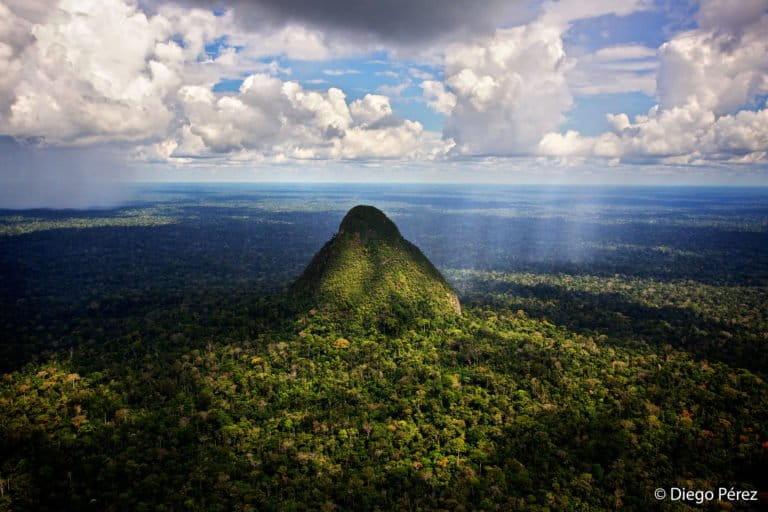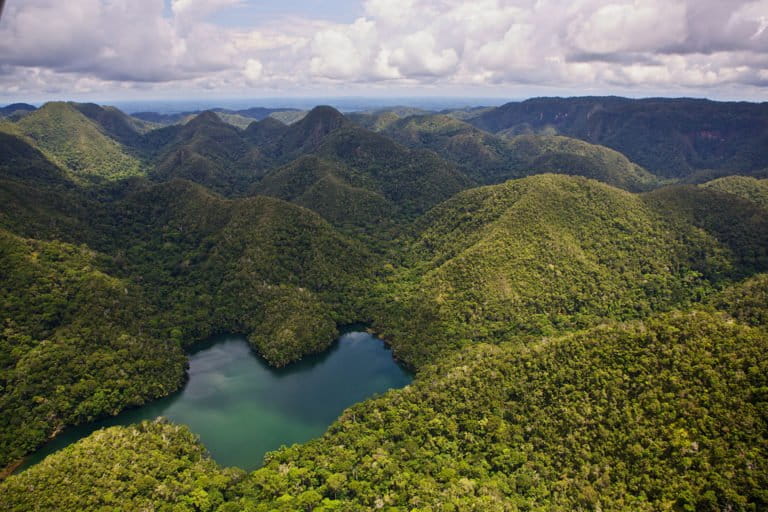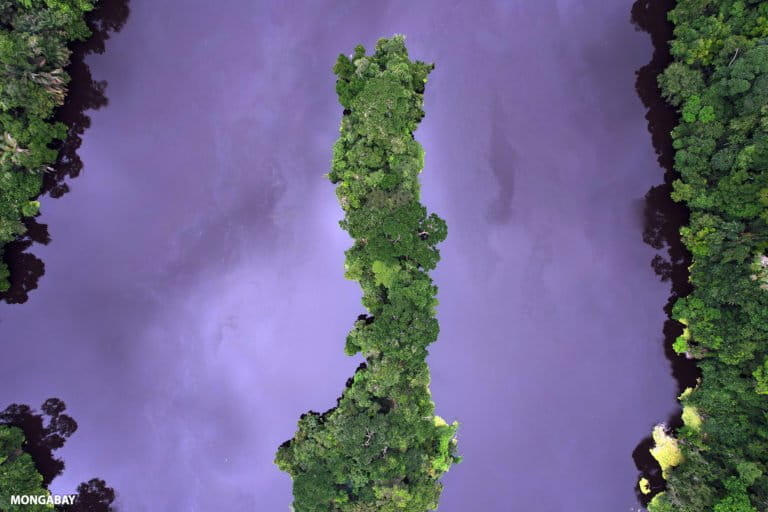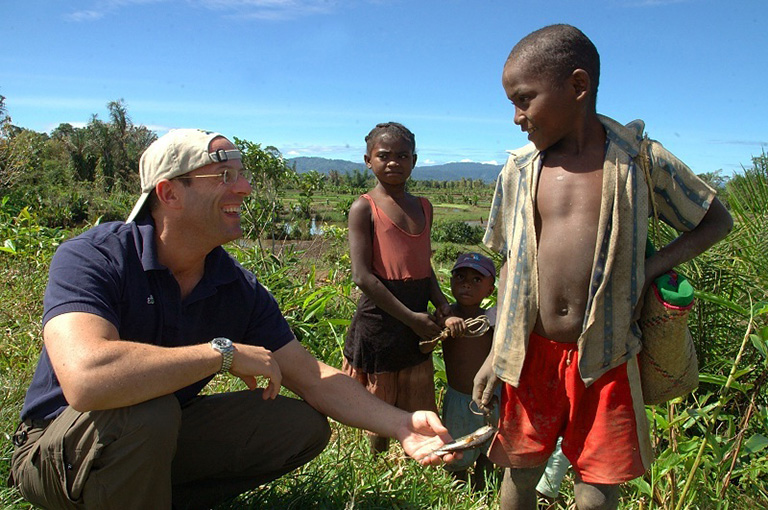
- Last month, Rainforest Trust committed $500 million to a $5 billion pledge to conserve biodiversity.
- The scale of Rainforest Trust’s commitment was surprising to some in the conservation world: just a decade ago, the Virginia-based group had an annual budget in the low single-digits millions. Now the organization is aiming to raise nine figures a year over the next five years — an incredible rate of expansion.
- Rainforest Trust is undertaking that ambitious target just 18 months after undergoing a major leadership transition: In April 2020, it appointed James Deutsch as CEO. Deutsch says the pledge will push Rainforest Trust to double down on its mission of creating and expanding protected and conserved areas through partnerships with other organizations. Rainforest Trust rallies the resources; partners lead the work on the ground.
- Deutsch spoke about the pledge and a range of other topics during a recent interview with Mongabay founder Rhett A. Butler.
Last month, nine organizations collectively announced a $5 billion pledge toward biodiversity conservation efforts worldwide. Most of the participants are philanthropic foundations, but one signatory is Rainforest Trust, a conservation group that committed $500 million.
The scale of Rainforest Trust’s commitment was surprising to some in the conservation world: just a decade ago, the Virginia-based group had an annual budget in the low single-digits millions. Now the organization is aiming to raise nine figures a year over the next five years — an incredible rate of expansion.
Rainforest Trust is undertaking that ambitious target just 18 months after undergoing a major leadership transition: In April 2020, it appointed James Deutsch as CEO. Deutsch joined Rainforest Trust after several years at the Paul G. Allen Family Foundation, where he oversaw the Great Elephant Census and worked on other biodiversity conservation initiatives under the umbrella of the late Microsoft co-founder’s personal philanthropy. Before that, he was Africa Director and then Vice President for Conservation Strategy at the Wildlife Conservation Society (WCS).

Deutsch says the pledge will push Rainforest Trust to double down on its mission of creating and expanding protected and conserved areas through partnerships with other organizations. Rainforest Trust rallies the resources; partners lead the work on the ground.
“We will continue to support land purchases, especially in the centers of endemism so critical for preventing species extinctions. But we will balance that with support for larger-scale park designations and indigenous titling projects, including in vast areas of intact forest — such as the Amazon and Congo,” he told Mongabay. “We will also support projects in forests particularly important for storing and sequestering carbon, such as mangroves and peat forests.”
“Every one of our projects is implemented on the ground by a community group or non-profit. Since I started here eighteen months ago I’ve chatted with most of our eighty or so partners, from the Center for Sustainability in Palawan, Philippines, to Strong Roots in the Democratic Republic of Congo, to CEDIA in Peru. Even over Zoom, these conservationists are incredibly inspiring — visionary, long-term committed to their countries, forests, and communities, and super-capable.”
Working with local partners is key to addressing two major gaps that currently limit conservation — equity and inclusivity — says Deutsch.
“First, conservation needs to solve the equity problem that the costs of conservation — such as loss of short term and local economic opportunities — is often born by local, rural people who can least afford it. The benefits of conservation, often flow to wealthier more distant people, whether they are tour operators or private individuals who care about gorillas. That inequity needs to be fixed,” he told Mongabay.
“Second, conservation will only scale up when non-conservationists, whether they are local and indigenous people or they are economists and industrialists, see its value.”

But conservation is only a part of what’s needed to stave off climate change and mass extinction. Speaking more broadly, Deutsch identifies three crucial levers to drive the systemic change needed to transform our relationship with the natural world.
“Economics, culture, and technology, in that order,” he said. “Although none of the social sciences are as successful as the natural ones at predictions, the most successful is economics. So above all we need to, as the economists say, “internalize the externalities” — that is stop providing free license to people and organizations to pollute the air, change the climate, destroy biodiversity, etc. The first step is a price on carbon.”
“But culture matters too, which is why the Greta Thunbergs of this world are so important. And technology can enable the changes we need to make, whether increasing renewable energy or monitoring forest loss.”
Deutsch spoke on these topics and more during a recent interview with Mongabay founder Rhett A. Butler.

AN INTERVIEW WITH JAMES DEUTSCH
How did you become interested in wildlife and conservation?
James Deutsch: I grew up in New York City, but when I was nine my parents sent me to a nature summer camp. Among other things, I remember the camp counselor seating us in a clearing and drawing in the dirt with a stick — and what he described was a new concept he was worried about called “the greenhouse effect.” Later, studying philosophy and searching for the meaning of life in college, I volunteered to help count vanishing black rhinos in northern Kenya, and I was hooked.
What are the biggest differences in conservation between when you got your start and now?
James Deutsch: Twenty years ago when I moved back into conservation after working in HIV/AIDS for a time, the scale and urgency of the AIDS crisis, especially in Africa, seemed much greater than anything in conservation. Today, in the middle of another pandemic, the catastrophic impact on humans of our destruction of nature has become much more clear. Though so much of the news is dire, I find hope in the fact that more and more people are taking the crises of climate change and biodiversity loss seriously.

You are now the CEO of Rainforest Trust and earlier this year, the organization developed a new strategic plan. What are the key elements of that? And are there any significant changes relative to the prior plan?
James Deutsch: We unanimously agreed to stick to our mission — funding partner NGOs in Latin America, Africa, and Asia to create and expand protected and conserved areas — but to scale up in order to have a measurable climate change as well as biodiversity impact. That means we will continue to support land purchases, especially in the centers of endemism so critical for preventing species extinctions. But we will balance that with support for larger-scale park designations and indigenous titling projects, including in vast areas of intact forest — such as the Amazon and Congo. We will also support projects in forests particularly important for storing and sequestering carbon, such as mangroves and peat forests.
In September 2021, Rainforest Trust made a $500 million commitment to conservation efforts, which seems like a staggeringly ambitious expansion. Can you tell us more about that?
James Deutsch: Seventy-two countries, most of them tropical nations in the developing world, have now signed on to the commitment to protect 30% of Earth’s lands and seas by 2030. The rest of the world needs to agree to this by May 2022. But that requires financing, and wealthy countries and institutions have been slow to commit funds. We hope that by being among the first to commit we will inspire other donors, private and public, to step up and commit financial support to 30×30 — and indeed we see that beginning to happen.

We were able to make this commitment because our donors — mostly concerned private individuals — have responded to the increased requests for our assistance with increasing levels of funding. This represents about twice our rate of grant-making over the past five years, which is a rate of growth we are confident we can achieve.
You have only about 35 staff — how can you possibly implement conservation on this scale?
Partners! Every one of our projects is implemented on the ground by a community group or non-profit. Since I started here eighteen months ago I’ve chatted with most of our eighty or so partners, from the Center for Sustainability in Palawan, Philippines, to Strong Roots in the Democratic Republic of Congo, to CEDIA in Peru. Even over Zoom, these conservationists are incredibly inspiring — visionary, long-term committed to their countries, forests, and communities, and super-capable.

We launch a new website later this year and look forward to highlighting our partners and their work in more detail.
Much of the focus around forests has been on their value in sequestering carbon, rather than other ecosystem services, especially water provision and biodiversity. Why is that? And do you think that is changing?
James Deutsch: The carbon value is global and quantifiable, in part because of the Stern Report and other efforts to unpick the economic impact of climate change. The causality between biodiversity loss and human well-being is real but harder to prove and quantify — though the Dasgupta report is a great start. And water provision is quantifiable but local — making it less likely that people on the other side of the world will pay for it.
I do think that over time we can quantify and market all these services so a wider range of ecosystems can be supported.
The conservation sector has historically taken a colonial approach to achieving its objectives, often ignoring or undermining Indigenous Peoples’ rights. But over the past decade, there’s been a rising emphasis on the role Indigenous Peoples, and local communities, play in stewarding ecosystems and wildlife. Still there are questions about the sincerity and follow-through on this approach by the sector as a whole, which is contributing to issues like pushback from some Indigenous rights groups against 30×30. What do you see as the key elements to addressing these issues?
James Deutsch: Unfortunately, many protected areas were created — just as many commercial farms, ranches, logging and mining concessions, etc. were created — by stealing land from the original owners. Today some 70% of the most important land in the world for biodiversity conservation is under indigenous ownership or management. The best way to ensure effective conservation of this land in the future is not to kick people off of it but to assist the traditional owners in their stewardship role.

Happily, we find that in many places in the world — not only the Amazon, but the Congo Basin, Eastern and Southern Africa, etc. — traditional landholders are extremely keen to protect their land from incoming mining and logging interests that will not in any case benefit them.
Historically 40% of all Rainforest Trust projects have provided indigenous or local communities with ownership or management rights. We are pledging to move that to at least 50%, but it could go much higher.
Beyond what you’ve covered so far in the interview, what do you see as other major gaps in conservation? Or in other words, where does conservation need to do better?
James Deutsch: Two things.
First, conservation needs to solve the equity problem that the costs of conservation — such as loss of short term and local economic opportunities — is often born by local, rural people who can least afford it. The benefits of conservation, often flow to wealthier more distant people, whether they are tour operators or private individuals who care about gorillas. That inequity needs to be fixed.
Second, conservation will only scale up when non-conservationists, whether they are local and indigenous people or they are economists and industrialists, see its value. We’ve made progress on both of these, but there is still lots to do.
You were formerly at Vulcan / the Paul G. Allen Family Foundation, which had a heavy emphasis on conservation technology. What technologies do you think have the most potential to support conservation efforts?
James Deutsch: The technology that has most revolutionized conservation over the past ten years, because it has collapsed costs by many orders of magnitude, is remote sensing of forest loss. For example, using Global Forest Watch, Rainforest Trust can provide real-time alerts to partners and monitor the effectiveness of every project we have ever funded, for pennies. We find, by the way, that less than 1% of the forest area protected with our support since 1988 has been deforested.

So the question is what is the next disruptive technology like this. Maybe ubiquitous satellite tags, like Ikarus. Maybe crowd-sourcing, like eBird. Maybe environmental DNA. Or will it be linking existing data sets with AI to add value?
Do you think the pandemic will teach us anything about how to live more sustainably? And if so, do you think any positive momentum will carry into the future?
James Deutsch: I think a significant reduction in business travel will be lasting. I would like to think that Covid reminded the world that we ignore solid scientific predictions about the future at our peril, with obvious implications for our response to predictions of climate change and biodiversity loss.
We face daunting challenges. What do you see as the key levers for driving the kind of systemic change required to transform humanity’s relationship with the natural world?
James Deutsch: Economics, culture, and technology, in that order. Although none of the social sciences are as successful as the natural ones at predictions, the most successful is economics. So above all we need to, as the economists say, “internalize the externalities” — that is stop providing free license to people and organizations to pollute the air, change the climate, destroy biodiversity, etc. The first step is a price on carbon.

But culture matters too, which is why the Greta Thunbergs of this world are so important. And technology can enable the changes we need to make, whether increasing renewable energy or monitoring forest loss.
What advice would you give to a young person considering a career in conservation?
James Deutsch: Go for it! Whether you are young or old, remember that conservation needs lawyers and politicians and sociologists and entrepreneurs and engineers, not only biologists. So whatever profession you are in, take your talents and experience and make the world a better place.
What would you say to young people who are distressed about the current trajectory of the planet?
James Deutsch: Shout about it. Fixing our broken relationship with nature requires greater focus on fairness between generations.
Conservation will only scale when non-conservationists see its value, says James Deutsch
Source: Trends News


0 Comments